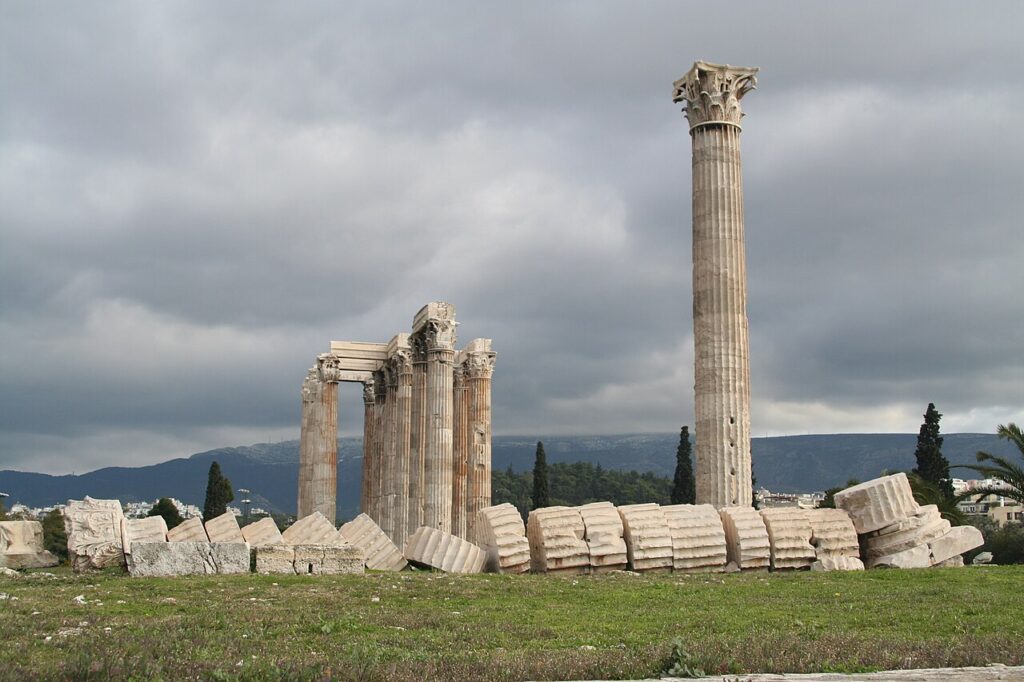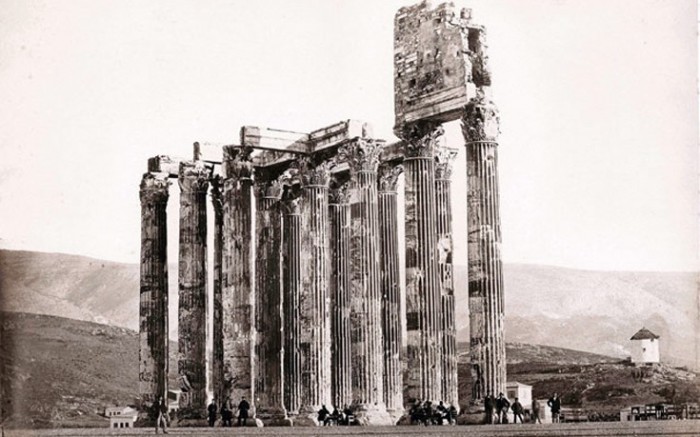Right in the heart of Athens stands the Temple of Zeus, also known as the Olympieion. It is one of the largest and most impressive sanctuaries of antiquity and took over half a millennium to complete.
The ancient travel writer Pausanias, who visited the Olympieion in the 2nd century AD, described it as one of the most impressive temples in the world. He noted the massive Corinthian columns and the magnificent statue of Zeus, which testify to the temple’s status as a symbol of power and divinity in both Greek and Roman times.
Standing at the site today, you are greeted by fifteen ancient columns rising toward the sky, their intricately carved capitals worn by time, battered by storms, lightning, fierce winds, wars, and natural disasters. A sixteenth column lies toppled, broken into segments as if a titan had abandoned their work halfway through. It is hard to imagine that this was once one of the most magnificent temples in the world – today, it is a relic that exudes both tranquility and the grandeur of a bygone era, wrapped in the hum and bustle of the city’s vibrant heart.
But beyond the temple’s grand history, there are also lesser-known stories – episodes visitors rarely hear.

The devastating storm of 1852
On October 14, 1852, the region of Attica was struck by a mighty storm, bringing intense rainfall and extreme gale-force winds that caused widespread destruction. Streets, homes, and farmland were flooded, trees were uprooted, and simple houses collapsed. In Piraeus Harbor, boats were washed ashore, and parts of the National Garden in Athens were destroyed. That same night, two earthquakes occurred, further intensifying the inhabitants’ sense of doom.
One of the most significant damages was the collapse of one of the 16 standing columns of the Olympieion. This column, which had stood for nearly two millennia, fell and broke into 18 pieces. The event was described as a “national tragedy” and caused great sorrow among the inhabitants of Athens. The leading newspaper of the time, “Αιών” (Aeon), reported:
“But the most tragic of all calamities was the fall of a colossal column from the Temple of Zeus, which collapsed fully along its entire length. We beheld this giant, 22 centuries old, lying prostrate upon the ground, divided into 18 immense fragments, and felt the power of God—manifesting either through natural forces or as a moral reminder. This column was the central one of the three that stood apart from the main structure of the temple.”
After the event, the authorities decided to surround the area with barbed wire to prevent the theft of pieces from the fallen column. However, this measure was criticized for its lack of aesthetics, and many suggested that an iron fence that fits the site’s historical significance should be installed instead.
Interestingly, the fallen column soon became part of the city’s social life. Cafés and beer halls opened nearby, and parts of the column were even used as tables, giving the site an unexpected role as a gathering place for discussions and socializing. Archaeologists and intellectuals consistently protested throughout this period against such activities taking place so close to a historical monument.
The Pillar Saints on the Temple of Zeus
During the Ottoman period in Athens, the temple’s columns are believed to have become a refuge for ascetic monks, known as pillar saints or stylites. These ascetics, seeking spiritual purification and closeness to God, are said to have lived atop the massive columns, which stand approximately 17 meters tall. There, they built small, simple dwellings and spent their days praying and meditating. Residents are said to have sent up food and water using ropes and buckets.
This theory was put forward in 2017 by the British author and researcher Paul M.M. Cooper. He suggested the possibility that the columns were used by stylites over the centuries. He arrived at this theory by analyzing historical photographs, where he discovered a peculiar structure on top of one of the columns. The structure’s regularity and placement prompted further investigation, and by studying paintings, lithographs, and other depictions from the same period, he concluded that it was likely a small building, probably made of bricks, used by ascetics.

His work, based on both visual sources and historical documents, has sparked renewed curiosity about the previously unknown historical aspects of the site. Although extensive contemporary sources are lacking, the theory offers a unique insight into how these ancient structures might have been used during the Ottoman period. While the theory is not fully confirmed, it adds a new dimension to our understanding of the temple’s history.
According to other sources, the columns were not only used by Christian hermits but also by Turkish Muslim ascetics. It is also said that Ethiopian slaves regarded the Temple of Zeus as a sacred place for prayer and devotion, where they gathered and performed rituals, especially during times of drought. Local legends also tell of supernatural beings said to leap between the columns on dark and stormy nights. These stories and traditions highlight the multifaceted history of the Olympieion, where ancient architecture, religious devotion, and folklore intertwine.
After Greece’s independence from the Ottoman Empire in the 19th century, efforts began to strengthen the national identity and restore ancient monuments to their original state. As part of these initiatives, the authorities decided to remove all structures added during the Ottoman period, including the small dwellings of the stylites atop the Olympieion’s columns. Another famous structure demolished in the 1870s was the Frankish Tower on the Acropolis.
The demolition of the stylites’ dwellings marked the end of this unique religious practice at the temple. Despite these measures, traces of the pillar saints’ presence remain in artworks from various periods, testifying to their historical significance for the Olympieion.
Hidden structures of the Olympieion unveiled
As Greek Reporter recently highlighted, recent research by the National Technical University of Athens has unveiled hidden structures beneath the Temple of Olympian Zeus using advanced geophysical techniques. These methods, including ground-penetrating radar and 3D imaging, allow archaeologists to explore subsurface features without excavation.
The team discovered a network of arched tunnels, originally part of a Roman sewer system, later repurposed during Greece’s War of Independence, 1821 – 1829. Additionally, radar imaging revealed a system of tanks and drains north of the temple, likely connected to its original drainage design. These non-invasive methods aid in ongoing restoration efforts and pave the way for future archaeological breakthroughs.
The Olympieion and the timeless legacy of Athens
Athens is more than just a city; it is a living testament to the passage of history. Here, layers of classical ancient architecture, Hellenistic creativity, Roman grandeur, Byzantine mysticism, and Ottoman influence come together to shape its identity. The Temple of Zeus, with its majestic columns and diverse uses over the centuries, reflects these eras uniquely.
Each era has left its mark – from ancient sanctuaries, where spirituality and cultural symbolism thrived, to Byzantine and Ottoman mysticism, as well as the oral storytelling traditions that followed. It is precisely these many layers that make Athens so captivating and give the site’s history a profound and timeless resonance.
Zeus temple – facts
- Temple
- Location: Athens, Greece
- Architectural Style: Classical
- Dedicated to: Zeus, the king of the Greek gods
- Construction Started: Begun in the 6th century BCE under the rule of Peisistratos
- Completion: Finished by the Roman Emperor Hadrian in 132 CE
- Size: One of the largest temples of antiquity, originally with 104 Corinthian columns, of which 15 remain standing today (the 16th fell in 1852).
- Significance: A symbol of both Greek and Roman power and ambition.
- Status Today: Preserved ruin and a popular attraction near Athens’ historic center.
- Architects: Antistatis, Kallaischros, Antimachides, and Phormos
Olympieion – Models and Reconstructions
Would you like to see how the Olympieion and its surroundings might have looked in antiquity? Visit Ancient Athens 3D and explore fascinating reconstructions of the site, created by Dimitris Tsalkanis in collaboration with Professor Chrysanthos Kanellopoulos of the University of Athens.
Sources: Wikipedia, mixanitouxronou.gr, in.gr, iefimerida.gr
The Expedition’s guided tours spring 2025 – see Athens with fresh eyes
Are you ready to delve deeper into the stories still whispered among the ruins? In the spring of 2025, we will take you to sides of Athens few have explored – where every step uncovers new layers of hidden or forgotten histories. Soon, you’ll be able to book your spot on our updated guided tours and become part of this journey through time and space. Stay tuned here for upcoming dates and more details.
